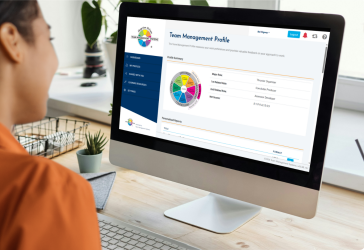As the gold standard for creating a high-performing team, the Team Management Profile (TMP) is a science-based feedback tool used for personal, team and leadership development. Utilising two models – one for high-performance and one for effective connection, the TMP is uniquely positioned to assist teams develop by improving processes and human interactions.
The TMP is not just about psychometrics, it’s about learning. Written in positive language, the TMP provides constructive, work-focused feedback that helps individuals understand why they work the way they do, and how they can develop strategies to improve the way they work with others. The TMP celebrates diversity and encourages inclusion through a common language that allows team members to recognise each other’s strengths in the workplace. When used effectively, the TMP can improve performance at all levels of an organisation, enabling positive, lasting change.
The Team Management Profile is a powerful self-analysis tool. A mirror that allows groups and individuals to self-assess without threat. It provides a window that encourages people to recognise the value of differences in work preferences and approaches.
Paul Macklin, Amazing People
What makes the TMP unique

Designed specifically for use in the workplace, the TMP takes into account the idea that people are different at work than they are at home or in other situations.
The profile is underpinned by two different models – a model of work and a model of people. This allows us to look at the work context in total – not just the people side and not just the process side, but both. The result is a holistic description of an individual’s preferred approach to work.
Whether used for team alignment, leadership coaching or project planning, the TMP delivers insight that’s immediately relevant and easy to act on — helping teams direct their energy to where it matters most.
Practical, visual data for real teams

The TMP makes team dynamics visible. By bringing individual profiles into team-level reports, the TMP shows where the group is balanced, where it might struggle and what can be done to improve performance.
The TMP provides the knowledge required to improve work performance at an individual and team level. When teams achieve a higher level of connection between their work preferences and job demands it increases the team’s energy, enthusiasm, commitment and motivation.
The TMP gives people a common language to talk about how work gets done. It highlights what drives each individual, how they contribute and where teams can focus to maintain momentum.
It helps teams and leaders:
- Work more effectively by understanding preferences and strengths
- Balance energy across the team to avoid overload or blind spots
- Create practical strategies for task allocation, communication and collaboration
- Build stronger team dynamics and a clearer sense of shared purpose
Using the TMP with Team Signals

Team Signals is a multi-rater engagement diagnostic and pulse-check tool that helps teams understand how they’re functioning right now, and where to focus next. It captures both leader and team perspectives, turning real-time feedback into clear development priorities.
When used alongside the TMP, it connects preference insight with real-time engagement, giving teams a clearer view of what’s working, what’s blocking momentum and what needs attention.
This combination is especially effective when:
- Teams are forming or struggling to perform consistently.
- Teams are in transition and need clarity on both roles and reality.
- Leaders want to connect self-awareness with team performance.
- Organisations are investing in sustainable capability and culture.
Together, TMP and Team Signals give teams the language, structure and visibility to lead with energy, clarity and intent.
Get started with TMP

To access the TMP you can enlist the services of one of our associates who are accredited in the profile, or you can become accredited to deliver a TMP debrief yourself.
Through an Accredited Practitioner gain access to TMS Global, our product delivery platform
- Answer the TMP Questionnaire
- Read your TMP report
- Attend a debrief with your Accredited Practitioner
Our other profiles
Opportunities-Obstacles Quotient (QO2) Profile
Building Capable Teams: CALIBRATE
The Opportunities-Obstacles Quotient (QO2) Profile is a unique tool designed to determine how individuals balance their efforts between seeing opportunities and obstacles, which influences their approach to risk. By enhancing team dynamics, it helps individuals understand their predispositions, manage responses to change, explore risk orientations, and build resilience. This comprehensive assessment aids leaders in improving decision-making, problem-solving, and goal clarification, ultimately enhancing their competitive advantage.
Window on Work Values (WoWV) Profile
Building Capable Teams: ALIGN
The Window on Work Values (WoWV) Profile is a comprehensive tool designed to enhance individual and team performance by aligning personal work values with organisational objectives. Measuring eight core value types—Individualism, Collectivism, Authority, Equality, Compliance, Empowerment, Independence, and Conformity—it provides detailed insights into individual motivations and behaviours. This understanding aids in identifying value alignment, addressing misalignment, and fostering team development through a customised Team Values Statement and Team Charter.
Linking Leader Profile (LLP|360)
Building Capable Leaders: LEAD
The Team Management Systems (TMS) view on leadership emphasises the importance of relationships. The Linking Leader Model identifies 13 essential Linking Skills across three levels: People Linking, Task Linking, and Leadership Linking. These skills are crucial for effective teamwork and leadership, ensuring sustainable high performance. The LLP|360 tool measures these skills and integrates them with established leadership theories, such as Transformational and Situational Leadership, to enhance leadership development programs.

